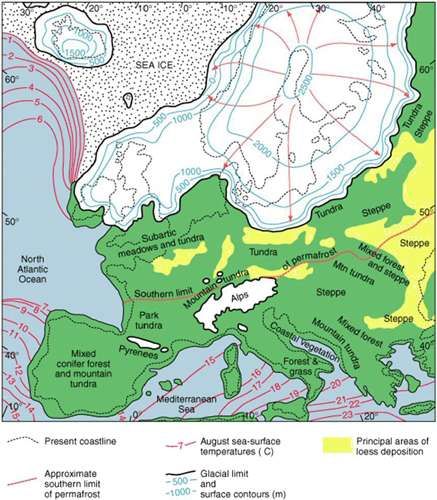Skrifennow
My blog, imported from Blogger and converted using Jekyll.
« Prev
1
2
3
4
5
6
7
8
9
10
11
12
13
14
15
16
17
18
19
20
21
22
23
24
25
26
27
28
29
30
31
32
33
34
35
36
37
38
39
40
41
42
43
44
45
46
47
Next »
Ebrenn y'n nos mis-Ebrel 2019
Here is the transcript for the Ebrenn y'n Nos segment for April 2019 for Radyo an Gernewegva, broadcast in #427:
Termyn a wra neyja yn sur ha gwaynten yw, hag yma mis-Ebrel ow talleth.
Nyns yw an nosow mar hir lemmyn, mes hwath yma taklow dhe weles.
Loor nowydh yw orth 5ves mis-Ebrel, an kynsa kwartron an 12ves, loor leun dhe’n 19ves ha’n diwettha kwartron 26ves, ha’n loor nowydh arta dhe’n 4a mis-Me. Meurth yw hwath gweladow yn gorthugher y’n ranneves Taurus, mes pell yw diworth a’n norvys yn y resegva, ha ny via meur gwelys a’n enep yn pellwelell. Yow ha Sadorn yw gweladow yn ebrenn kyns an bora, isel y’n soth-est.
Yma kowas sterennow kodha an Lyrids an mis-ma. An gwella termyn dh’aga gweles yw 22a - 23a mis-Ebrel. Y fydh ogas hag 20 a sterennow kodha pub our ow mos dhyworth an ranneves Lyra, yn north-est an ebrenn.
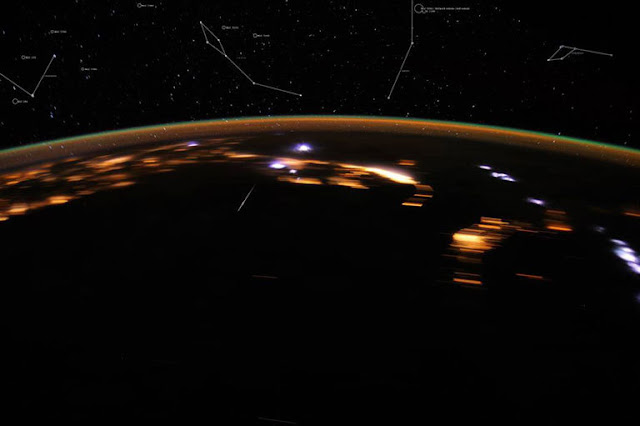 |
| Imaj: NASA solarsystem.nasa.gov/asteroids-comets-and-meteors/meteors-and-meteorites/lyrids/in-depth |
mars.nasa.gov/news/8413/nasas-opportunity-rover-mission-on-mars-comes-to-end
An wandryell ma o sewen bras yn gwiryonedh, drefenn an ragres derowel o saw dhe dhurya 90 dydh ha viajya 1000 meter. Hi a dhuryas 14 bloedh, ha viajya moy ages 45km. www.jpl.nasa.gov/news/news.php?release=2014-245
mars.nasa.gov/news/8420/opportunitys-parting-shot-was-a-beautiful-panorama
mars.nasa.gov/resources/22341/opportunity-legacy-pan
www.popsci.com/last-mars-opportunity-rover-picture-panorama#page-3
Opportunity a dhiskudhas dustuni a vonow gwrys gans dowr linyel yn termyn eus passyes war enep Meurth. Yma imaj a olow Opportunity gans titel Kernewek avel rann a’n ragres HiRISE Kernewek: www.uahirise.org/kw/ESP_013954_1780
Yma gwrandryell arall NASA, Curiosity hwath owth oberi. Hi a wrug kemmer imajys difygow an howl diworth Meurth: mars.nasa.gov/news/8425/curiosity-captured-two-solar-eclipses-on-mars/
mars.nasa.gov/resources/22393/curiosity-observes-deimos-eclipse-sol-2350
mars.nasa.gov/resources/22392/curiosity-observes-phobos-eclipse-sol-2359
Yma dew loor dhe Veurth, mes byghan yns i hag ytho nyns yw an difygow kowal.
https://mars.nasa.gov/msl/mission/whereistherovernow/
https://mars.nasa.gov/msl/mission/mars-rover-curiosity-mission-updates/
Yma an tirell “Insight” owth oberi ynwedh, ow musura an gewer war enep Meurth. Dhe 2a mis-Ebrel, yth esa an tempredh ughella -17°C ha’n isella -98°C war Elysium Planitia.
Y fydh gwandryell nowydh henwys “Mars 2020” lonchys gans NASA yn mis-Gortheren 2020, hag y’n keth mis, gwrandryell Europek ExoMars.
An gwrandryell ExoMars a wra bos henwys “Rosalind Franklin” wosa kymygydhes a wrug kevri dhe dhiskudhans framweyth DNA.
exploration.esa.int/mars/61114-esas-mars-rover-has-a-name-rosalind-franklin
An savla-tira Oxia Planum yw ombrofyer an moyha komendys: exploration.esa.int/mars/60914-oxia-planum-favoured-for-exomars-surface-mission hag ervirans finel a vydh diwettha an bledhen ma.
An ombrofyer arall yw “Mawrth Vallis” wosa Mawrth yn Kembrek. exploration.esa.int/mars/60915-exomars-landing-sites-in-context
Yma nebes nansow war Veurth henwys a-wosa an planet Meurth yn lies yeth. Martesen yma le a yll kavos hanow “Meurth Vallis” yn termyn a dheu?
An hwrithrell Chinek Chang’e-4 a diras war eneb pell an loer neb nag yw treylys bythkweth dhe’n norvys yn kowdoll “Von Kármán”.
www.astronomy.com/news/2019/01/chinas-change-4-mission-lands-on-moons-far-side-snaps-first-image
planetary.org/blogs/jason-davis/change4-success.html
Dhe kestava orth an tirell yth esa edhomm dhe China lonchya lorell arall dhe dhannvon an messajys ynter a’n norvys ha’n hwrithrell.
spacenews.com/change-4-relay-satellite-enters-halo-orbit-around-earth-moon-l2-microsatellite-in-lunar-orbit/
spacenews.com/change-4-powers-down-for-second-lunar-night/
spacenews.com/change-4-spacecraft-enter-third-lunar-night-yutu-2-reaches-design-lifetime/
Yma an hwrithrell efanvos OSIRIS-Rex ow pesya studhya an planetik Bennu. Ev a wrug arhwilans gans laser rag gul model 3D a’n planetik.
www.asteroidmission.org/bennu-visualized-by-ola-large/
Yma enep an planetik Bennu pur arow, gans karregi byghan ha bras.
www.asteroidmission.org/?latest-news=nasa-mission-reveals-asteroid-big-surprises
www.asteroidmission.org/?attachment_id=15551#main
www.planetary.org/blogs/emily-lakdawalla/2018/news-brief-osiris-rex-orbit.html
An planetik Ryugu ha’n hwrithrell Nihonek Hayabusa 2 orth y studhya, yw karnek ynwedh: www.hayabusa2.jaxa.jp/en/topics/20190328e_illustration/
Drefenn yw an enep moy garow es o gwaytys, yth esa edhomm delatya tirans an hwithrell. Byttegyns, an hwithrell a diras dhe’n 22a mis-Hwevrer rag termyn berr ha lonchya arta.
www.hayabusa2.jaxa.jp/en/topics/20190220e_TDPoint/
www.hayabusa2.jaxa.jp/en/topics/20190221e_TD1-L08E1_Schedule/
www.hayabusa2.jaxa.jp/en/topics/20190225e_TD1_W1image/
twitter.com/haya2e_jaxa
An hwithrell “New Horizons” a dremenas 2014 MU69 “Ultima Thule”, ha’y studhya.
www.planetary.org/blogs/emily-lakdawalla/2019/looking-back-at-mu69.html
http://pluto.jhuapl.edu/News-Center/News-Article.php?page=20190102
http://pluto.jhuapl.edu/News-Center/News-Article.php?page=20190103
http://pluto.jhuapl.edu/News-Center/News-Article.php?page=20190115
http://pluto.jhuapl.edu/News-Center/News-Article.php?page=20190124
http://pluto.jhuapl.edu/News-Center/News-Article.php?page=20190222
http://pluto.jhuapl.edu/News-Center/News-Article.php?page=20190307
http://pluto.jhuapl.edu/News-Center/News-Article.php?page=20190318
http://pluto.jhuapl.edu/Galleries/Featured-Images/image.php?gallery_id=2&image_id=603
An taklenn a’n jeves shap koynt, gans dew rann stegys warbarth.
www.planetary.org/blogs/emily-lakdawalla/2019/mu69-baby-comet-contact-binary.html
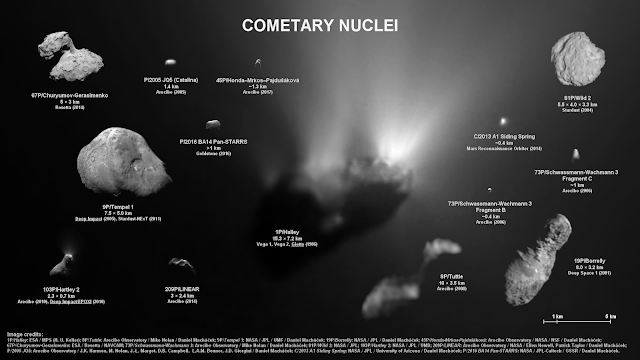 |
Pyth yw ‘bi-lobed contact binary’ yn Kernewek? Planetik dewek kestavek gans dew lapp? Nag yw rond an dhew lapp mes hirbelyek ha plattys yns.
Moy leven yw y enep es po Bennu po Ryugu, yth yw taklenn a’n sort steren lostek na wrussa dos nes dhe’n howl. Yth esa Ultima Thule formys hag y dhew lapp keskwattya yn lent hag yn medhel, hag yth i a wrug glena warbarth.
Bys nessa prys,
Davydh Trethewey
An gwrandryell gwyls
Yth esen vy gwrandryell dres lies bledhen
My re wrug ow batris fest gwaghes yn tien
My re wrug dehweles data termyn hir
Mes ny wrav vy rosya namoy dres an tir
Nag eus nerth vyth genev
Ny wrug howlsplann bos krev
Lowr dhe dhaskarga'n batris
Ha sinella'n norvys
Yth ethen dhe gowdoll a wren vy a-rag
Leveris orth NASA ow rosow o stag
Yn mysk an tewennow ow sedhi ens i
Mes my a wrug rydhhe ow rosow gans bri
mars.nasa.gov/resources/5874/opportunitys-rub-al-khali-panorama
Nag eus nerth vyth genev
Ny wrug howlsplann bos krev
Lowr dhe dhaskarga'n batris
Ha sinella'n norvys
Yth esa an doust war ow fanellys howl
Martesen yth esa an diwedh ow thowl
Hag arta an gwyns a wrug aga glanhe
Nerth o gans ow batris pan hwrug howl krevhe
Nag eus nerth vyth genev
Ny wrug howlsplann bos krev
Lowr dhe dhaskarga'n batris
Ha sinella'n norvys
Soweth yth esa hi ow kul tewedh
Doust a-dro Meurth ny wren vy godhvos bythkweth
An tewlder a dhuryas an nos hag an jydh
Ow fanellys howl ny wrug ri dhymm nerth vyth
Nag eus nerth vyth genev
Ny wrug howlsplann bos krev
Lowr dhe dhaskarga'n batris
Ha sinella'n norvys
mars.nasa.gov/resources/5617/opportunity-catches-its-shadow
My re wrug ow batris fest gwaghes yn tien
My re wrug dehweles data termyn hir
Mes ny wrav vy rosya namoy dres an tir
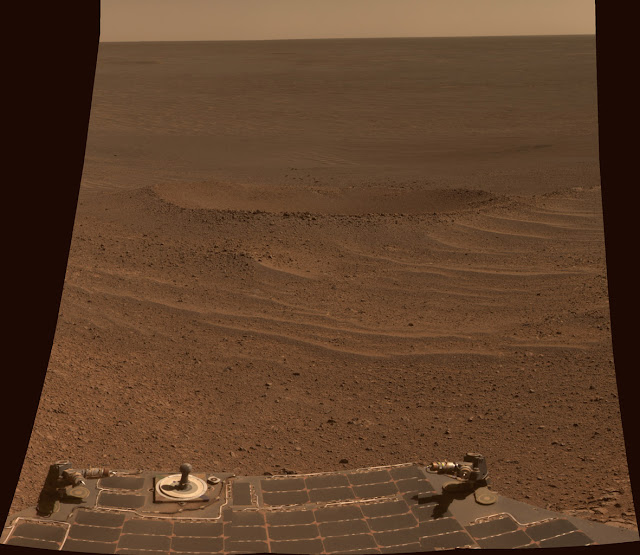 |
| Imaj: www.jpl.nasa.gov |
Nag eus nerth vyth genev
Ny wrug howlsplann bos krev
Lowr dhe dhaskarga'n batris
Ha sinella'n norvys
Yth ethen dhe gowdoll a wren vy a-rag
Leveris orth NASA ow rosow o stag
Yn mysk an tewennow ow sedhi ens i
Mes my a wrug rydhhe ow rosow gans bri
mars.nasa.gov/resources/5874/opportunitys-rub-al-khali-panorama
Nag eus nerth vyth genev
Ny wrug howlsplann bos krev
Lowr dhe dhaskarga'n batris
Ha sinella'n norvys
Yth esa an doust war ow fanellys howl
Martesen yth esa an diwedh ow thowl
Hag arta an gwyns a wrug aga glanhe
Nerth o gans ow batris pan hwrug howl krevhe
 |
| mars.nasa.gov/news/8420/opportunitys-parting-shot-was-a-beautiful-panorama |
Nag eus nerth vyth genev
Ny wrug howlsplann bos krev
Lowr dhe dhaskarga'n batris
Ha sinella'n norvys
Soweth yth esa hi ow kul tewedh
Doust a-dro Meurth ny wren vy godhvos bythkweth
An tewlder a dhuryas an nos hag an jydh
Ow fanellys howl ny wrug ri dhymm nerth vyth
Nag eus nerth vyth genev
Ny wrug howlsplann bos krev
Lowr dhe dhaskarga'n batris
Ha sinella'n norvys
mars.nasa.gov/resources/5617/opportunity-catches-its-shadow
New research show elephants first created Cornwall's road network
Researchers at the University of North Cornwall are working on a new project indicating that much of Cornwall's road network was created by elephants trampling the native vegetation.
Elephants lived in the British Isles, including Cornwall during the Ipswichian interglacial (also known as Eemian) epoch between 130,000 years ago and 115,000 years ago, when temperatures were similar to or slightly warmer than at present, before the last glacial period.
See the following link by George Monbiot: www.monbiot.com/2015/06/15/thinking-like-an-elephant/
Elephants will have made tracks over most of Britain, however in much of this area, the tracks would surely have been erased by ice sheets in the Last Glacial Maximum.
Elephants travelling on their favourite routes in Cornwall would over time create enduring tracks by trampling and browsing of vegetation, and compaction of soil. These routes would be more easily followed by other wildlife, and eventually humans. There would also have been additional resources due to the distribution of plant seeds and improvement of soil nutrients by elephant droppings.
The research used a download of the secondary, tertiary and unclassified road network in Cornwall, from OpenStreetMap. Primary and trunk roads were ignored since they are liable to be on modern alignments.
Cornwall was contrasted with Cumbria, since any elephant tracks would be expected to be erased there during the last glacial period.
The secondary, tertiary and unclassified roads have various numbers of features in the different areas:
The numbers of features, total road length, mean and median length in the clusters are:
Cornwall has 2 clusters (0 and 6 in the far west, and north Cornwall respectively) that are much smaller in terms of number of features than the other 3, indicating that certain clusters, notably the two largest clusters, labelled 3 and 5 have a dense road network which originated when elephants followed river valleys in their migrations in search of food sources.
Cluster 0 in North Cornwall is less dense possibly due to episodic glaciation of Bodmin Moor and surrounding areas erasing elephant tracks.
Cumbria in contrast has relatively evenly sized clusters, apart from cluster 2 which is larger than the rest, correlated with a flatter topography than the rest of the area.
The remaining clusters are similar in number of features and average line length. This is to be expected due to the erasure of the pre-glacial elephant migration routes.
Conclusion
The relative high density of the Cornish minor road network is shown in this work to originate in tracks created by elephants in the 130-115 kyr BP interglacial, and potentially maintained through the glacial period by seasonally migrant wooly mammoth grazing the tundra vegetation available in Cornwall in the summer during the glacial period. In contrast, in areas that were glaciated including Wales and Cumbria the elephant tracks were erased, resulting in a different road network topology.
Elephants lived in the British Isles, including Cornwall during the Ipswichian interglacial (also known as Eemian) epoch between 130,000 years ago and 115,000 years ago, when temperatures were similar to or slightly warmer than at present, before the last glacial period.
See the following link by George Monbiot: www.monbiot.com/2015/06/15/thinking-like-an-elephant/
 |
| Historical average temperature on Earth (Wikimedia Commons) |
 |
| A model of a straight-tusked elephant (Palaeoloxodon antiquus) (Credit: BBC Earth/Apotea) |
Elephants will have made tracks over most of Britain, however in much of this area, the tracks would surely have been erased by ice sheets in the Last Glacial Maximum.
 |
| Ice sheets in Europe during the Last Glacial Maximum |
 |
| Woolly mammoth were able to reach their summer pastures in Cornwall by crossing the Channel river - either in sections where it was broad and shallow, or during the spring before the ice melted. |
Elephants travelling on their favourite routes in Cornwall would over time create enduring tracks by trampling and browsing of vegetation, and compaction of soil. These routes would be more easily followed by other wildlife, and eventually humans. There would also have been additional resources due to the distribution of plant seeds and improvement of soil nutrients by elephant droppings.
The research used a download of the secondary, tertiary and unclassified road network in Cornwall, from OpenStreetMap. Primary and trunk roads were ignored since they are liable to be on modern alignments.
 |
| Were some of these roads built by elephants? |
 |
| Cumbria in northern England was covered in thick ice sheets during the last glacial period, so it is presumed that any traces of elephants from the previous interglacial are erased. |
 |
| Northern Wales was similarly covered by a thick ice sheet. |
 |
| Modelling of the last glacial period in Wales (Patton et al 2012) researchgate.net/publication/248381136_The_last_Welsh_Ice_Cap_Part_1_-_Modelling_its_evolution_sensitivity_and_associated_climate. |
The secondary, tertiary and unclassified roads have various numbers of features in the different areas:
- Cornwall - 9730
- Cumbria - 9704
- Wales - 30775
 |
| there are the Isles of Scilly, and a spurious feature off the map, so there are really 7 clusters here |
 |
| 5 K-means clusters of the minor road network in Cumbria |
Cornwall:
- 0: 1001, 846km, 845m, 455m
- 3: 2689, 1406km, 523m, 257m
- 4: 2034, 1375km, 676m, 403m
- 5: 2597, 1597km, 615m, 293m
- 6: 1308, 596km, 456m, 215m
Cumbria:
- 0: 2104, 1202km, 571m, 232m
- 1: 1754, 802km, 457m, 213m
- 2: 2468, 1929km, 782m, 344m
- 3: 1793, 861km, 480m, 213m
- 4: 1585, 914km, 576m, 241m
Cornwall has 2 clusters (0 and 6 in the far west, and north Cornwall respectively) that are much smaller in terms of number of features than the other 3, indicating that certain clusters, notably the two largest clusters, labelled 3 and 5 have a dense road network which originated when elephants followed river valleys in their migrations in search of food sources.
Cluster 0 in North Cornwall is less dense possibly due to episodic glaciation of Bodmin Moor and surrounding areas erasing elephant tracks.
Cumbria in contrast has relatively evenly sized clusters, apart from cluster 2 which is larger than the rest, correlated with a flatter topography than the rest of the area.
The remaining clusters are similar in number of features and average line length. This is to be expected due to the erasure of the pre-glacial elephant migration routes.
Heatmap of road intersections (10km kernel size)
 |
| In Cumbria, there is a lower density of road intersections due to the erasure of previous interglacial elephant migration tracks during the last glacial period. |
 |
| The secondary, tertiary and unclassified road network in Wales, in 15 clusters to keep the average number of features broadly comparable to the previous work. |
 |
| Outside the major urban areas, the density of the road junctions are markedly lower in Wales than in Cornwall, indicating elephant tracks were erased in the last glacial maximum. |
The relative high density of the Cornish minor road network is shown in this work to originate in tracks created by elephants in the 130-115 kyr BP interglacial, and potentially maintained through the glacial period by seasonally migrant wooly mammoth grazing the tundra vegetation available in Cornwall in the summer during the glacial period. In contrast, in areas that were glaciated including Wales and Cumbria the elephant tracks were erased, resulting in a different road network topology.
Ebrenn yn nos mis-Genver 2019
Here is the transcript for the Ebrenn y'n Nos segment for January 2019 for Radyo an Gernewegva, broadcast in #413:
Ottani dhe’n diwedh 2018 ha mires a-rag orth bledhen nowydh 2019.
Yma meur a taklow ow hwarvos lemmyn yn kever efanvos.
An lester-efanvos NASA, OSIRIS-REx a wrug dos dhe’n planetik Bennu, hag a wrug y dhrehedhes an tressa mis-Kevardhu. Ev o lonchys an 8ves Gwynngala 2016.
Yma Bennu planetik diantell, drefenn bos ev yn resegva gans galloes skwattya an norvys. Yma chons onan yn 2700 ev dhe skwattya an norvys ynter an bledhennyow 2175 ha 2199. Kynth yw saw 492 a veter y myns, y fia euthyk mar kwra ev skwattya an norvys. OSIRIS-Rex a wra studhya Bennu, ha’n towlenn yw dhe gemmer sampel an 4a mis-Gortheren 2020 gans tava an planetik gans bregh robotek. Mar kwra puptra mos yn ta, an sampel a wra dehweles dhe’n norvys yn mis-Gwynngala 2023.
New Horizons, an hwithrell a dhresneyjyas Pluto, a wra dresneyja an taklenn grogys Kuiper (486958) 2014 MU69 dhe Dy’Kalann 2019. An taklenn ma yw henwys yn ansodhogel “Ultima Thule”. Ev a vydh 43.4 unnses steroniethel a’n howl ha New Horizons y dresneyja. Onan unnses steroniethel yw pellder an howl dhe’n norvys. http://www.planetary.org/blogs/emily-lakdawalla/2018/0124-new-horizons-prepares-for-2014mu69.html
Yma hwrithrell nowydh war enep Meurth. An tiror “InSight” a diras dhe’n hwegves warn ugens mis-Du. Yma seismometer ha hwrithrell gwaskedh ayr dhedhi. Dre hemma, yth yw possybl dhe glywes an gwyns war Meurth.
Ottomma nebes an son, ughelhes gans 2 oktav:
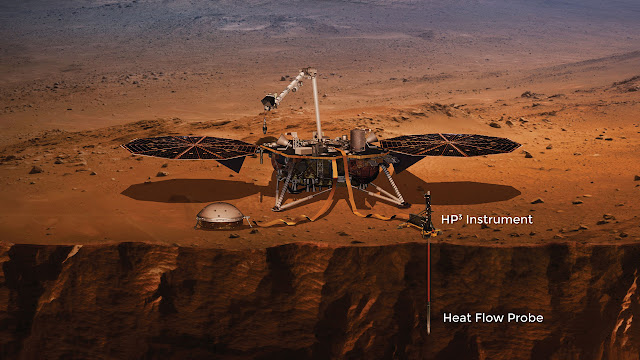 |
Yma tarder dhedhi ynwedh a wra musura tempredh dor Meurth bys dhe pymp meter yn-dann an enep. https://mars.nasa.gov/insight/spacecraft/instruments/hp3/ |
https://www.nasa.gov/feature/jpl/mars-new-home-a-large-sandbox
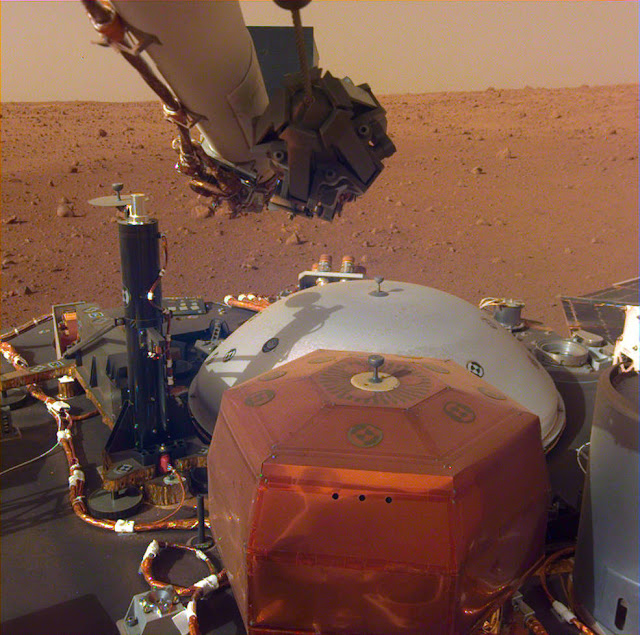 |
| Imaj diworth https://www.nasa.gov/feature/jpl/nasas-mars-insight-flexes-its-arm |
Soweth, nag eus nowodhow diworth an gwrandrell “Opportunity” war enep Meurth. Yma NASA hwath ow koslowes orth sinell radyo dhiworto.
An hwrithrell howl Parker a wrug hy hynsa nesheans dhe’n howl yn salow 6ves mis-Du, hag a wra dos ogas dhe’n howl arta yn mis-Ebrel.
Yth esa loer leun 22a mis-Kevardhu, ha diwetta kwarter 29ves mis-Kevardhu. Yma loer nowydh 6ves mis-Genver, kynsa kwarter 14ves mis-Genver, loer leun 21a mis-Genver, ha diwettha kwarter 27ves mis-Genver.
Yma difyk an loer dhe’n 21a mis-Genver, mes y fydh res difuna a-varr orth y weles.
Skeus an norvys yw diberthys ynter ‘umbra’ ha ‘penumbra’, henn a styr, yn leow y’n umbra, an howl leun yw gorherys, mes yn penumbra saw rann an howl yw gorherys. Yn difyk, an loer yn hy resegva a movya dre skeus an norvys.
Mars yw an loer saw yn skeus penumbra, nyns yw an difyk apert, mes mars yw an loer yn umbra, yth yw an loer gans brath kemmerys dhe ves.
Yn difyk kowal an loer, oll an loer yw yn umbra, ha tewl, mes nebes golow dasfreythys dre ayrgylgh an norvys a dhrehedhes an loer hwath. Awos henna, yth yw hwath gweladow, rudh ha tewl.
An difyk umbra a durya a 03:33 bys dhe 06:50, ha’n difyk kowal a 04:41 bys dhe 05:43.
https://www.rmg.co.uk/discover/explore/lunar-eclipse
 |
| Imaj diworth https://www.eclipsewise.com/lunar/LEprime/2001-2100/LE2019Jan21Tprime.html |
An planetys, Yow ha Sadorn yw re ogas dhe’n howl y’n ebrenn lemmyn orth y weles, mes Meurth yw hwath yn ebrenn gorthugher ha Gwener yw gweladow yn bora, avel “Borlowen”. An hen Grekyon a’n jevo dew hanow rag Gwener Hesperus yn gorthugher ha Phosphoros yn bora, kynth yns I an keth planet. Dhe’n 6ves mis-Genver, Gwener yw orth hy brassa pellder yn ebrenn diworth an howl. Res yw difuna a-varr ha mires orth an ebrenn est kyns an howldrevel.
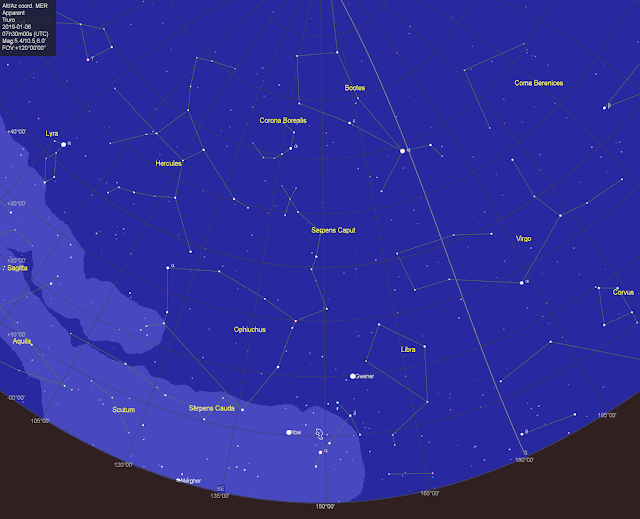 |
| 07:30 kh 6ves mis-Genver 2019, ow mires orth an soth-est. Gwrys gans Cartes du Ciel |
Bys nessa prys ha bledhen nowydh da dhywgh hwi oll!
Ebrenn y'n Nos mis-Hedra 2018
Here is the transcript for the October 2018 segment of Ebrenn y'n Nos (Sky at Night) broadcast in Radyo an Gernewegva #400
Kepar hag y’n hav ma, yma nebes planetys y’n ebrenn gorthugher. Yow yw kales dhe weles lemmyn, isel yn ebrenn soth-west wosa an howl dhe sedha. Sadorn yw isel yn Soth wosa howlsedhes, hag a wra sedha kyns unnek eur, hag a-varra diwettha yn mis
Meurth yw apert isel yn Soth yn gorthugher, yn rannneves Capricornus, mes le a splannder es mis-Gortheren, drefenn nyns yw mar ogas lemmyn. Dhe dhalleth mis-Hedra y vraster yw -1.3 ha diwedh mis-Hedra -0.6. Henn yw hwath moy splann es pub sterenn gweladow a Gernow saw Sirius.
NASA a wrug lonchya an Hwithrell Howl Parker an 12ves mis-Est. An towl yw dhe studhya an howl ha'n hwithrell mos moy ogas es pub hwithrell arall kyns. Dhe’n 13ves mis-Gwynngala, an system yeynhe o skychys yn fyw, ha dowr ow mos dre an panellys howl ha dewynnadoryon dhe lehe tempredh an lester-efanvos.
yth
https://blogs.nasa.gov/parkersolarprobe/2018/09/14/parker-solar-probes-solar-array-cooling-system-fully-activated/
An hwithrell howl Parker a wra mos dhe'n ogassa 3.8 milvil a vildiryow diworth an howl. Ev a wra durya seyth blydhenn dhe mos ena, hag usya gronnedh an planet Gwener yn unn dresneyjya dhe kavoes an uskitter bras dhe neshe an howl. An kynsa nesheans dhe'n howl a vydh mis-Du an vlydhen ma.
An norvys yw trydhek milvil ha peswar ugens a vildiryow diworth an howl. Ytho, pan vydh an hwithrell yn y resegva finel, krevder an howlsplann a vydh bys dhe 600 gweyth y grevder omma.
Y fydh res usya skeus-toemmder, gans tewder a 4.5 meusva, gwrys a "komposit karbon". Ny yll an hwithrell mires orth enep an howl, awos krevder an howlsplann ena, mes yma daffar dhe studhya an mesyow tennvenek, temmigow nerthek an gwyns howl ha'n ayrgylgh howl, an korona.
Ny wrug an wandrell NASA 'Opportunity' war Meurth bos kestavys hwath. An wandrell a wrug kestava an norvys diwettha dhe’n 10ves mis-Metheven, wosa moy es peswardhek blydhen war enep Meurth a-ban 2004. Yth esa tewedh doust bras war Meurth, ha nyns esa howlsplann lowr rag hy fanellys howl. Dhe dhalleth mis-Gwynngala, myns doust yn ayrgylgh Meurth a-dro dhe Opportunity o isella, hag ynjinoryon NASA a wra tybi bos howlsplann lowr dhedhi dhe dhaskarga hy batri. I a wra assaya hy hestava pub dydh. Govenek a’m beus vydh an wandrell ma klewys arta. Y’n termyn a dheu, martesen lestri radyo Goonhelghi a wra keskommunyans an par ma.
Moy a gedhlow diworth: https://mars.nasa.gov/news/8360/six-things-about-opportunitys-recovery-efforts/
An lester-efanvos Nihonek Hayabusa 2, a wrug drehedhes an planetik Ryugu an Metheven ma, a sewenas lonchya y dhiw wandrell vyghan, henwys MINERVA-II-1 (yth yw akronym, kales dhe dreyla dhe Gernewek - Micro nano experimental robot vehicle for Asteroid, the second generation). An gwandrellyow a wrug tira war an planetik kynsa warn ugens mis-Gwynngala. An planetik Ryugu yw ogas hag unn kilometer a-hys.
An gwandrellyow yw ogas hag unn kilogramm kettep onan. I a yll lyfansas a-dro dhe’n planetik, ha tenna skeusennow anodho ha mesura tempredh hag erell. Dre usya an dhiw anedha, i a yll musura an shap trymynsek. Gans pub lamm, drefenn bos an gronnedh pur wann, an wandrell a yll lyfansas 15 meter, ha’n lamm a dhurya pymthek mynysenn. I a wra oberi yn omrewlys, heb edhomm gortos rag gorhemmynadow diworth an norvys pub termyn.
Ebrenn y’n nos - mis-Hedra 2018
Yn hanter-bys north, ottani yn kynyav. An howl a wra esedha a-varra pub nos, ha'n nosow dhe hirhe. Tredhegves warn ugens mis-Gwynngala o an kehysnos, ha'n nos kehys ha'n dydh.Kepar hag y’n hav ma, yma nebes planetys y’n ebrenn gorthugher. Yow yw kales dhe weles lemmyn, isel yn ebrenn soth-west wosa an howl dhe sedha. Sadorn yw isel yn Soth wosa howlsedhes, hag a wra sedha kyns unnek eur, hag a-varra diwettha yn mis
Meurth yw apert isel yn Soth yn gorthugher, yn rannneves Capricornus, mes le a splannder es mis-Gortheren, drefenn nyns yw mar ogas lemmyn. Dhe dhalleth mis-Hedra y vraster yw -1.3 ha diwedh mis-Hedra -0.6. Henn yw hwath moy splann es pub sterenn gweladow a Gernow saw Sirius.
NASA a wrug lonchya an Hwithrell Howl Parker an 12ves mis-Est. An towl yw dhe studhya an howl ha'n hwithrell mos moy ogas es pub hwithrell arall kyns. Dhe’n 13ves mis-Gwynngala, an system yeynhe o skychys yn fyw, ha dowr ow mos dre an panellys howl ha dewynnadoryon dhe lehe tempredh an lester-efanvos.
yth
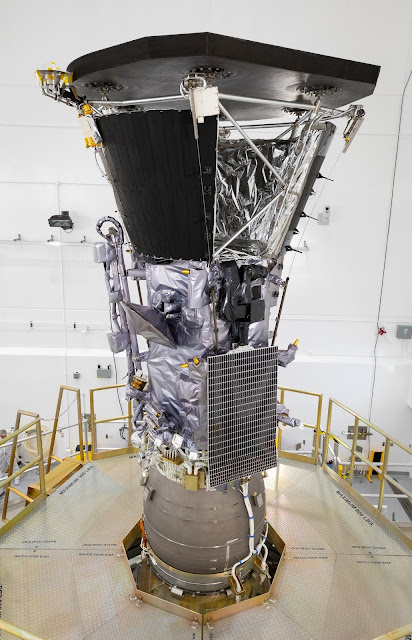 |
| An Hwrithrell Howl Parker kyns ev dhe vos lonchys. Notyewgh an dewynnadoryon du a-wartha dhe'n hwithrell ha'n skeus-toemmder orth an topp. |
https://blogs.nasa.gov/parkersolarprobe/2018/09/14/parker-solar-probes-solar-array-cooling-system-fully-activated/
An hwithrell howl Parker a wra mos dhe'n ogassa 3.8 milvil a vildiryow diworth an howl. Ev a wra durya seyth blydhenn dhe mos ena, hag usya gronnedh an planet Gwener yn unn dresneyjya dhe kavoes an uskitter bras dhe neshe an howl. An kynsa nesheans dhe'n howl a vydh mis-Du an vlydhen ma.
 |
| Yth esa an lonch 12ves mis-Est 2018, an kynsa dresneyjyans Gwener 3a mis-Hedra, ha'n kynsa howlnesva 6ves mis-Du. parkersolarprobe.jhuapl.edu/The-Mission/index.php#Journey-to-the-Sun |
Y fydh res usya skeus-toemmder, gans tewder a 4.5 meusva, gwrys a "komposit karbon". Ny yll an hwithrell mires orth enep an howl, awos krevder an howlsplann ena, mes yma daffar dhe studhya an mesyow tennvenek, temmigow nerthek an gwyns howl ha'n ayrgylgh howl, an korona.
Ny wrug an wandrell NASA 'Opportunity' war Meurth bos kestavys hwath. An wandrell a wrug kestava an norvys diwettha dhe’n 10ves mis-Metheven, wosa moy es peswardhek blydhen war enep Meurth a-ban 2004. Yth esa tewedh doust bras war Meurth, ha nyns esa howlsplann lowr rag hy fanellys howl. Dhe dhalleth mis-Gwynngala, myns doust yn ayrgylgh Meurth a-dro dhe Opportunity o isella, hag ynjinoryon NASA a wra tybi bos howlsplann lowr dhedhi dhe dhaskarga hy batri. I a wra assaya hy hestava pub dydh. Govenek a’m beus vydh an wandrell ma klewys arta. Y’n termyn a dheu, martesen lestri radyo Goonhelghi a wra keskommunyans an par ma.
Moy a gedhlow diworth: https://mars.nasa.gov/news/8360/six-things-about-opportunitys-recovery-efforts/
An lester-efanvos Nihonek Hayabusa 2, a wrug drehedhes an planetik Ryugu an Metheven ma, a sewenas lonchya y dhiw wandrell vyghan, henwys MINERVA-II-1 (yth yw akronym, kales dhe dreyla dhe Gernewek - Micro nano experimental robot vehicle for Asteroid, the second generation). An gwandrellyow a wrug tira war an planetik kynsa warn ugens mis-Gwynngala. An planetik Ryugu yw ogas hag unn kilometer a-hys.
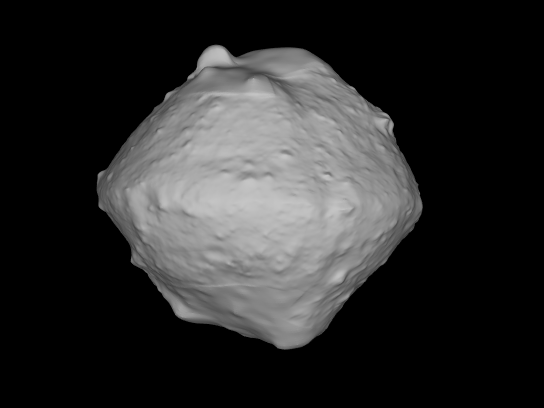 |
| Shap an planetik Ryugu gwrys gans Pennskol Kobe. Kevrenn: www.hayabusa2.jaxa.jp/topics/20180711bje/index_e.html Kredit imaj : Kobe University, University of Aizu (shape model creation), Auburn University (video creation), JAXA |
 |
| An gwrandrellyow MINERVA-II 'Hibou' ha 'Owl' www.hayabusa2.jaxa.jp/en/topics/20180919e www.hayabusa2.jaxa.jp/en/topics/20181213e_MNRV-II1 |
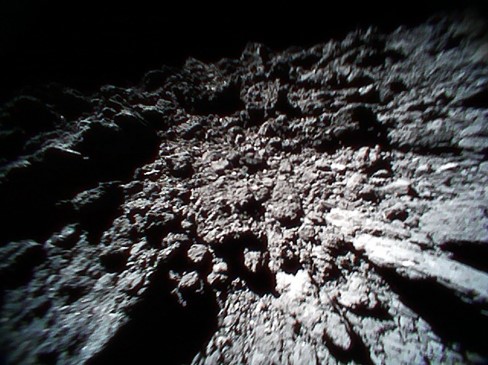 |
| Imaj ensampel an enep diworth an wrandrell 1B 'Owl'. www.hayabusa2.jaxa.jp/en/topics/20180927e_MNRV |
« Prev
1
2
3
4
5
6
7
8
9
10
11
12
13
14
15
16
17
18
19
20
21
22
23
24
25
26
27
28
29
30
31
32
33
34
35
36
37
38
39
40
41
42
43
44
45
46
47
Next »


